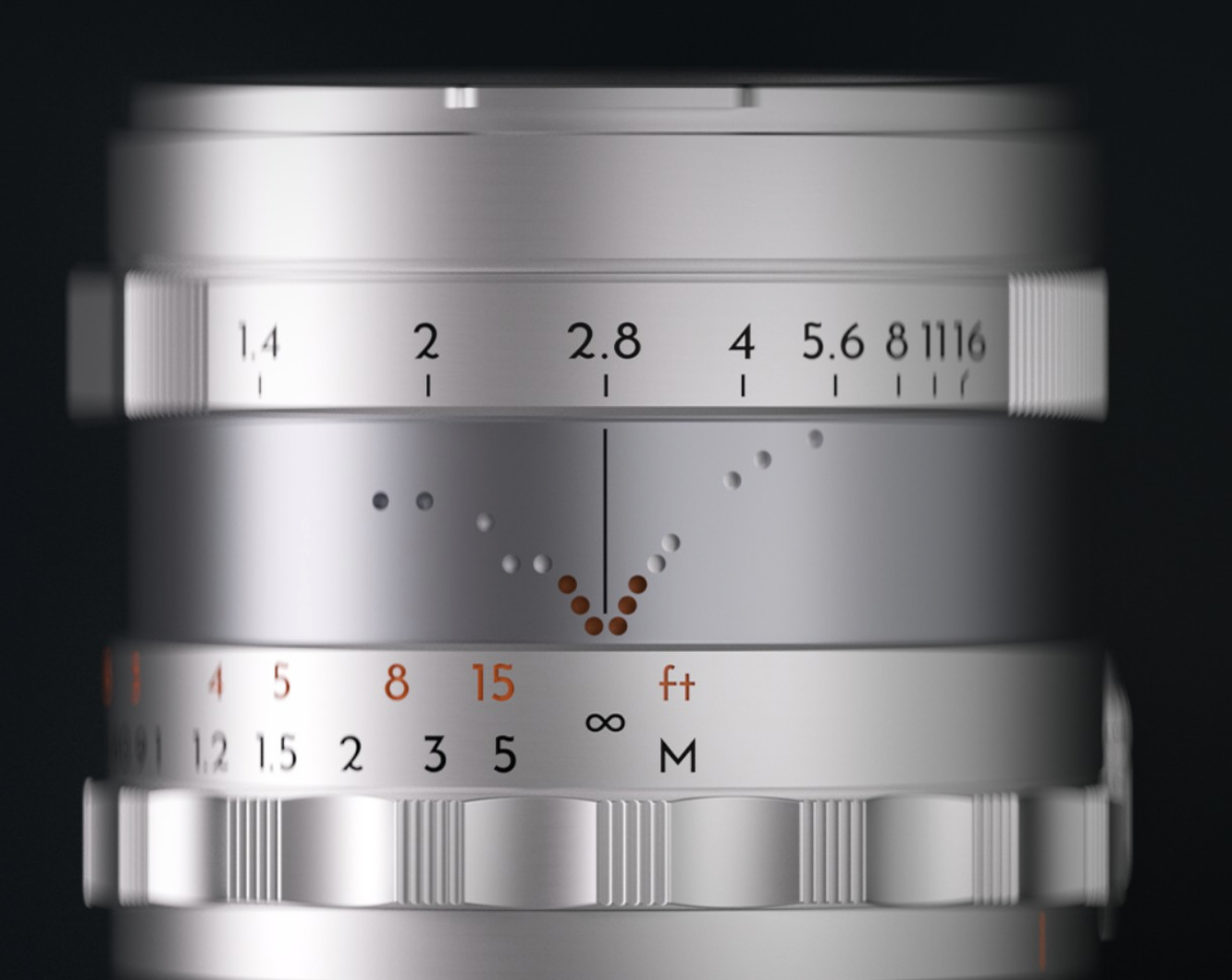Our weekly news round continues with a new M-Mount lenses featuring an automatic depth-of-field scale. There’s also a w(eir)dly named, vowelless panoramic digital full-frame camera with “viewfinder” aspirations, a design for a Lego M6, and a reminder of desirable Leica camera/lens bundles. We are also bringing tips on Leica’s perspective control, and news of the worst product name of the year.
M lens with a new automatic depth-of-field scale

Once upon a time, M-Mount lenses came mainly from three companies, Leica, Zeiss and Voigtländer. Now, the choice is vast, and it is almost impossible to keep a track of all the different manufacturers, many of them in China, now adopting the venerable 70-year-old camera mount.
One that caught my eye this week (a tip of the cap to reader Mike Mallett for this) comes from another new name, Thypoch. Two new lenses, the close-focus Simera 28mm and 35mm f/1.4, boast an unusual method of demonstrating depth of field.
But first, the name. For students of Greek, Thypoch Simera will sound very familiar. Simera is Greek for “today” while “thy” and “epoch” evoke “your” and “fixed point”. Someone has done some serious study in coming up with the nomenclature, and I approve wholeheartedly. The company was introduced at Photopia Hamburg in September 2023. However, despite the Hellenic allusions, Thypoch lenses come from the M-iddle Kingdom, just like TTArtisan and most of the other newcomers.

According to reviewer Keith Wee, “Thypoch has released a lens that is a step up from the offerings of TTArtisan and closer to Voigtländer and Light Lens Lab in terms of quality. It is a brand worth paying attention to.”
The outstanding visual feature of the two new lenses is the unique depth-of-field scale. It provides an automatic depth-of-field indicator, which is easier to read and understand than relying on the traditional scale markings of most M-Mount lenses.
Another excellent review of the new lenses, “a Leica lover’s dream lens”, comes from Almog Kolt of DIY Photography. Both the 28mm and 35mm Simeras will retail for around $700, he says. Furthermore, have a look at the Thypoch website, which includes full details of the lenses and links to retailers in many parts of the world.
There is little doubt that Chinese manufacturers have put some new life into the traditional M-Mount, and the Simeras twain represent a welcome ingenuity.
Worst camera product name of the year
Camera lens nomenclature is an arcane science which would be envied by car badge designers of the 1970s and 1980s. Every possible attribute must be mentioned, however unlikely it is that the poor customer will understand. Even Leica is not immune, with its “Vario-Elmarit-SL 24-70”, although the company manages to avoid the worst excesses. And when it comes to the venerable M lenses, the nomenclature is pithy and precise, totally informative with the least possible fuss: Leica Summicron-M 50 f/2. Do we need any more?

The Japanese manufacturers are perhaps the worst offenders in constructing confusing and wordy product titles. Fstoppers.com has organised an impromptu competition to find the “worst product name of the year”. Hang your head in shame, Panasonic, for this egregious effort:
Panasonic Leica DG Vario-Elmar 100-400mm F4.0-6.3 II ASPH. POWER O.I.S.

Leica M6 camera project listed on Lego Ideas
Why not make a Leica M6 out of Lego blocks? A poster on Lego Ideas explains how he has made “an old vintage Leica camera”. It’s a handsome looking beast that even includes an opening back with a film cassette in place. Find out more at Lego Ideas. More pictures here at Leica Rumours.
Review of Perspective Control

If you are a fan of Leica’s perspective control feature on the Q3 and M11, you owe yourself a visit to Sean Reid’s website, where he looks in detail at perspective control and features various workflow options for using it. As usual, Sean’s insights are masterful.
Reid Reviews is a subscription-based service and costs just under $50 a year. For this, you get access to independent reviews and informative articles, such as the one on perspective control. Jonathan Slack is a good friend of Sean, and they often spark off one another when assessing new hardware.
If you would like to learn more about perspective control and an incredible back-catalogue of Leica and photography reviews, visit Read Reviews here.
Vwfndr Keirin panoramic digital camera
You can’t buy it yet, but this vowelless panoramic digital camera is likely to be produced in Japan in 2025. It’s the name “V(ie)wf(i)nd(e)r”, that caught my attention. But if you imagine a new viewfinder camera, perhaps a competitor for the Pixii, I think you are likely to be sorely disappointed. According to PetaPixel, where you can read more details, the camera is a “reductionist” idea by the studio Nuevo.Tokyo in collaboration with design Mireia Gordi Vila: “The project shows a minimalist camera body with an expansion bay, a panoramic curved rear display and touch controls.”
The design studio is promising further hardware and software details next month. Already, they have said that the specification will include a 35mm lens and a full-frame 3:2 60-MP sensor, with panoramic formats created by digital crops. Images here from the Nuevo.Tokyo website.


Leica SL2-S bundles make sense
It’s an open secret that the new Leica SL3 will be launched in March, and there are currently camera and lens bundles available at reduced prices. In the UK, a saving of £1,200, via cashback voucher, is possible until January 31 when you purchase any new Leica SL lens with a new Leica SL2 body. It is possible that the scheme could be extended, but no word of that so far. Full details here.

The Leica X Vario we never saw
Our nostalgic article on the trials and tribulations of the Leica X Vario on January 10 prompted Alan Chimacoff to send this picture of a mock-up of the promised X Vario which appeared on the internet during the “Mini M” phase of the pre-launch publicity. Alan tells us that he was captivated by this prospect and was suitably distressed when the X Vario showed none of the flair of this version.

My initial reaction on seeing this, for the first time this week, was that it reminded me of another camera, not the X Vario. That camera, which launched little more than a year after the actual X Vario, was the Leica T. I now wonder if some rumour-monger had inside information but got the wires crossed. What do you think?
Join the Macfilos subscriber mailing list
Our thrice-a-week email service has been polished up and improved. Why not subscribe, using the button below to add yourself to the mailing list? You will never miss a Macfilos post again. Emails are sent on Mondays, Wednesdays, and Fridays at 8 pm GMT. Macfilos is a non-commercial site and your address will be used only for communications from the editorial team. We will never sell or allow third parties to use the list. Furthermore, you can unsubscribe at any time simply by clicking a button on any email.


The dof scale is a copy of Alpa Kern Macro-Switar from 60 years ago… https://classic.leica-camera.com/media/9d/5d/e4/1682101047/33937_52.jpg
Thanks for this. It will be useful if ever we have the opportunity to review one of these lenses.
I think this feels like a missing link. It appears to have a detachable lens that also has an aperture ring. If that’s the case is it an M lens or something different? I can’t read what’s written on the lens in terms of focal length or aperture.
It appears to have an “A” on the shutter speed dial but I can’t see if there’s an “A” on the aperture ring. Also not visible is an exposure compensation dial where you might expect it to be.
So what is this thing???
The lens engraving reads ‘Noctilux-MC f0.95/35 ASPH’.
I’d guess this is a mock-up of a proposed ‘MC’ (M-Compact?) APS-size camera, taking interchangeable M lenses, with the 35mm lens giving something close to an equivalent of a 50mm lens on the smaller sensor.
Perhaps this is why the publicity build-up called the proposed camera a ‘Mini-M’, but in the end that concept was thrown out (camera not actually ready?) and the completely different X-Vario was substituted. This has manual apertures, manual focusing, Manuel and his Music of the Mountains, Manual and Auto shutter speeds, screen on the back, no viewfinder ..a predecessor of the T. You can see what looks like the edge of a large rear screen on the backside of its twin at the right edge of the picture.
Exposure compensation? ..Via the rear touchscreen.